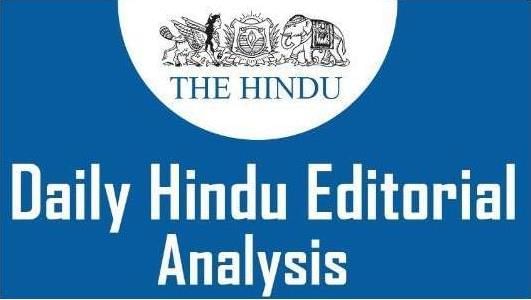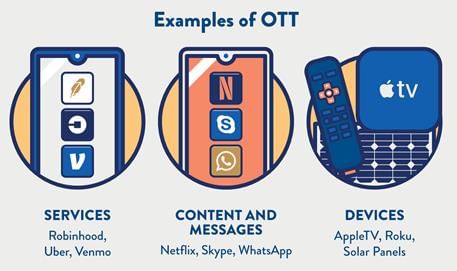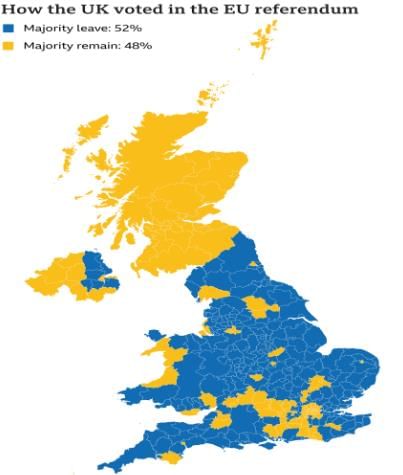The Hindu Editorial Analysis- 26th December, 2020 | Additional Study Material for UPSC PDF Download

1. Recharging DTH: Guidelines For Obtaining the Licence For Providing DTH Service
GS 3- Science and technology
Context
The Union Cabinet has approved the proposal for revision of the guidelines for obtaining the license for providing Direct-To-Home broadcasting service in India.
About New Guidelines
- Licence period: Unlike the present, where 10 years licence is provided, guideline revised it for 20 years. as well as the period of License may be renewed by 10 years at a time.
- Licence fee: As well as License fee has been revised from l0% of GR to 8% of AGR. This AGR will be calculated by deduction of GST from GR. Proposal for its reduction was given six-year before by the regulator, TRAI.
- Collection of licence fee: At present License, Fee is collected on an annual basis while new guidelines reduced it with a quarterly basis.
- Channel carrying capacity: DTH operators shall be permitted to operate to a maximum of 5% of its total channel carrying capacity as permitted platform channels.
- Registration fee: A one-time non-refundable registration fee of Rs.10,000 per PS channel shall be charged from a DTH operator.
- Sharing of instruments: Now the DTH operators, willing to share DTH platform and transport stream of TV channels, voluntarily, will be allowed.
- Distributors of TV channels will be permitted to share the common hardware for their Subscriber Management System (SMS) and Conditional Access System (CAS) applications.
- FDI: The cap of 49% FDI in the existing DTH guidelines will be the line up with the extant Government (DPIIT's) policy on FDl as amended from time to time.
- The decision will come into effect as per revised DTH guidelines are issued by the Ministry of Information and Broadcasting.
Benefits of These New Guidelines
- The proposed reduction is intended to align the license fee regime applicable to the Telecom sector and will be prospectively applied.
- Increased investment: The difference may also enable DTH service providers to invest for more coverage and to increased operations and higher growth, thereby enhanced and regular payment of License
- Increased revenue: Registration fee for Platform Services is likely to bring a revenue of approximately Rs. 12 Lakhs.
- Sharing of the infrastructure by the DTH operators may bring in more efficient use of scarce satellite resources and reduce the costs borne by the consumers.
- Adoption of the extant FDI policy will bring in more foreign investment into the country.
- In this flux environment, some existing players have combined technologies, incorporating DTH, Internet service and OTT. So after the licence fee decision, there is relief among the DTH players.
- Against the existing annual licence fee, there is a legal challenge in the Supreme court, this challenge was posted for hearing next year.
Challenges Before DTH Operators
- They are facing a challenge from high bandwidth Internet and new generation entertainment providers using Over The Top (OTT) channels.
- These channels are removing at their urban viewer base so they are valuable to advertisers.
- As well as many broadcasters have a live Internet presence, and also have newer screencasting technologies pair mobiles to large screen TVs.
Over The Top Platform
- It is a streaming media service offered directly to viewers via the Internet.
- It bypasses cable, broadcast, and satellite television platforms.

New Tariff Order of Trai
- It was issued in January 2020. It amended the tariff order of 2017.
- This order lowered the price cap of an individual channel that is part of a bouquet to ?12 per month from ?19 earlier.
- And order also restrict the discount on channel bouquets to about 33%.
- This order was challenged in court by Star and Disney India, Sony Pictures Network India and TV18, along with the Indian Broadcasting Foundation and the Film and TV Producers Guild of India.
- They challenged the order because the order increased the available channels for a mandated network capacity fee paid to platforms like DTH, also reduced the maximum price of pay channels in bouquets.
About Trai
- It is a statutory body set up by Telecom Regulatory Authority of India Act, 1997.
- It was set up in 1997.
- It is the regulator of the telecommunications sector in India.
Common Man
- These measures strike a disappointment for the common man.
- While major platforms accepted the network fee provision, the channels have resisted at regulation.
- As well as India is one of the biggest single markets for audiences.
- In India, there is an estimated 200 million cable and satellite households.
- In recent time there is controversy surrounding fake audience numbers for channels.
- Hence there is a need for scrutiny of the methods adopted.
- Broadcasters of India like state run Doordarshan must realise is that audiences are won by the power of authentic programming and entertainment.
- As we know that India is a country of diversity with a vibrant public sphere and a sporting tradition, there is space for everyone.
- So to win the viewer's favour there is a need for the combination of technology and pricing.
2. Limits of Sovereignty
GS 2- Effect of policies and politics of developed and developing countries on India’s interests
Context
- Days before the post-Brexit transition expires, the tariff-free trade accord in goods that the U.K. and the EU signed on Thursday mitigates somewhat the consequences of Britain’s narrow decision, in 2016, to leave one of the largest trading blocs.
- The eleventh-hour agreement prevents a catastrophic ‘no deal’ scenario.
Brexit
The term Brexit, coined by former lawyer Peter Wilding, is a blend of two words - "Britain" and "exit". He wrote about "Brexit" in May 2012. As the name suggests, the United Kingdom’s divorce with the European Union is known as Brexit.
➢ What is the European Union?
The European Union (EU) is a grouping of 28 countries that trade and allow their citizens to move freely between nations to work and live. Initially, it was built on the ruins of World War II to end centuries of bloodshed and to integrate economic power.
What Do We Know About the Deal?
- The deal contains new rules for how the UK and EU will live, work and trade together.
- No taxes on each other's goods when they cross borders (known as tariffs)
- No limits on the amount of things which can be traded (known as quotas)
- European Commission president Ursula Von der Leyen said competition rules - designed to prevent one side gaining an unfair advantage - "will be fair and remain so".
- She said the UK and EU will "continue co-operating in all areas of mutual interest, including things like climate change, energy, security and transport".
- We also know the UK will not be taking part in the Erasmus exchange programme for students.
Prospects
- The country now faces a potential 4% loss of GDP over 15 years, compared to remaining in the EU.
- Leaving without any agreement would have led to a potential loss of 6% of GDP, estimates the fiscal watchdog.
- Moreover, given the U.K.’s reliance on the EU for about 75% of food product imports, the significance of zero duty trade for consumers and the retail economy cannot be exaggerated.
- Brexit’s biggest trade-off for the ordinary citizen is perhaps the restrictions on the right to free movement and work.
- The tariff-free access to Europe’s single market has been realised in exchange for guarantees that Britain would not undercut EU competition rules and environmental regulations.
- Among the more contentious issues in the talks, the arrangement allays apprehensions about the potential economic threat from the “Singapore-on-Thames” growth model the U.K. might pursue outside the EU.
- The biggest stumbling block was the access for EU fisheries to British seas, which London was keen to reclaim as demonstration of wresting sovereignty after Brexit.
- There is now a five-and-a-half-year transition period that guarantees continued access for the affected EU states.
- The reduced terms for the latter are expected to help British fisheries. A major challenge now would be to keep border checks and red tape to the minimum, besides ensuring that supply chains are not unduly disrupted.
- U.K. businesses have given a cautious welcome to the agreement, which has left the EU market in services out of its purview, requiring Britain’s pre-eminent financial services sector to negotiate ad hoc measures with European counterparts.
“Singapore-On-Thames”
The phrase “Singapore-on-Thames” is shorthand for Britain becoming a low-tax, lightly regulated economy that can out-compete the sclerotic, over-regulated eurozone from a strategic position only 20 miles or so offshore. The general idea was first mooted a couple of years ago by Philip Hammond, then Britain’s chancellor of the exchequer, as a means of encouraging the EU to strike a friendly Brexit deal with the UK.
Why Did The Deal Take So Long?
- Because so much was at stake. The EU is the UK's nearest and biggest trading partner, The UK government says the deal covers trade that was worth £668bn in 2019.
- While the UK was in the EU, companies could buy and sell goods across EU borders without paying tariffs.
- Without the deal, businesses would have had to start paying these taxes, which would have added to their costs.
- No deal would have also meant even more border checks, which could have caused delays for lorries transporting products.
What Happens Next?
- Even though the deal has been agreed, it still needs to be made law.
- For that to happen it must be looked at and approved by both the UK and European parliaments.
- As it's been left so late, the European Parliament won't have time to sign it off before the end of the year. That shouldn't stop the deal coming into force on 1 January, but it will take longer before it's officially rubber-stamped.
- The UK government says it will summon MPs back on 30 December to vote on the deal. However, there wouldn't be time to debate and look at the details closely.
Conclusion
Both sides are relieved there is a deal, but people and businesses don't have much time to prepare for the changes starting on 1 January.
3. Article 356 and An Activist Judiciary
GS 2- Indian Judiciary
"In framing a government which is to be administered by men over men, the great difficulty lies in this; you must first enable the government to control the governed; and in the next place oblige it to control itself," said James Madison.
Context
- The recent order of the Andhra Pradesh High Court directing the Andhra Pradesh government to come prepared to argue on the ‘breakdown of constitutional machinery in the state’ is shocking as it opens up the possibility of use or even misuse of Article 356 by the judiciary. The Andhra Pradesh High Court could pass such an order due to the presence of the term ‘otherwise’.
- Though the Supreme Court of India has stayed the order, we need to go deeper into this observation and look at the controversial provision of Article 356 because of which the High Court could make such an observation.

Story Behind the Inclusion
- No liberal democratic Constitution in the world has a provision such as Article 356 that gives the central government the power to dismiss a democratically-elected State government except the Constitution of Pakistan.
- Both India and Pakistan borrowed this provision from the Government of India Act, 1935.
- Interestingly, the leaders of our freedom struggle were so very opposed to this provision that they forced the British government to suspend it; thus, Section 93 of the Government of India Act, 1935 was never brought into effect.
- The provision which we had opposed during our freedom struggle was incorporated in the Constitution strangely in the name of democracy, federalism and stability.
- On June 11, 1947, it was agreed in the Constituent Assembly that the Governor could use this emergency power.
- By this time the Governor was supposed to be elected by the people of the State rather than nominated by the Centre.
- Govind Ballabh Pant did say that by mere elections, Governors will not become all wise.
- G.B. Pant and Hirday Nath Kunzru opposed it and termed it as virtual reproduction of the 1935 Act. H.N. Kunzru defied the whip and voted against it.
- Laxmi Kant Maitra and Tangutri Prakasam said that Indian Governors would not behave like British Governors who acted as agents of the Centre.
- Alladi Krishnaswami justified the provision in the name of representative government at the Centre.
- Subsequent decades proved all of them wrong both in respect of Governors as well as the central government.
The Power of a Word
- After several revisions, provision became Article 278 (now Article 356).
- H.V. Kamath termed it as "a surgical operation for a mere cold".
- He criticised the word ‘otherwise’ because otherwise’ can include anything including a presidential dream of breakdown of constitutional machinery in a state.
- As the Governor had been made a nominee of the Centre by this time, he asked why the President could not have confidence in his own nominees.
- It was called a ‘retrograde step’ and that ‘we are reducing the autonomy of the states to a farce.’
The Record
- Article 356 has been used/misused more than 125 times though B.R. Ambedkar had assured that it would remain a dead letter.
- Both on Article 356 and the Governor, in almost all cases it was used for political considerations rather than any genuine breakdown of constitutional machinery in the States.
Instances of Inflicting More Wounds
- In the very first invocation of Article 356 in 1951, Jawaharlal Nehru removed the Gopi Chand Bhargava ministry in Punjab though he enjoyed the majority.
- In 1959, it was used against the majority opposition government of the E.M.S. Namboodripad government in Kerala and Governor B. Ramakrishna Rao in his report argued that the government had lost ‘support of overwhelming majority of people’ and belittled the fact of it enjoying the confidence of [the] House.
- Indira Gandhi has the dubious distinction of using Article 356 as many as 27 times, and in most cases to remove majority governments on the ground of political stability, absence of clear mandate or withdrawal of support, etc.
- But the Janata government did worse than Mrs Gandhi by removing nine majority Congress governments in one stroke on April 30, 1977.
- Mrs Gandhi replied in the same currency on her return to power in 1980 by removing nine Opposition majority governments at one go.
- Subsequent governments too acted in similar fashion including the Narendra Modi government which invoked Article 356 in Arunachal Pradesh on Republic Day itself, in 2016.
- The most notable case of non-use of Article 356 was the refusal of the P.V. Narasimha Rao government prior to the demolition of the Babri Masjid on December 6, 1992 as in the draft Constitution, emergency power could be used to safeguard the ‘legitimate interests of minorities’ and the government was fully aware of a breakdown of constitutional machinery in Uttar Pradesh.
Conclusion
- Today, when many constitutional experts are of the view that the judiciary is increasingly becoming more executive-minded than the executive itself, the observations of the Andhra Pradesh High Court are a worrisome sign.
- Ideally, the word ‘otherwise’ should be deleted from Article 356 and the provision be used only sparingly and to never remove a majority government.
- Judicial activism may be good as a rare exception but an activist judiciary is neither good for the country nor for the judiciary itself as it would encourage the government to appoint committed judges.
|
21 videos|562 docs|160 tests
|
FAQs on The Hindu Editorial Analysis- 26th December, 2020 - Additional Study Material for UPSC
| 1. What are the guidelines for obtaining a licence for providing DTH service? |  |
| 2. What are the limits of sovereignty? |  |
| 3. How does Article 356 relate to an activist judiciary? |  |
| 4. What is the significance of the 26th December 2020 UPSC exam? |  |
| 5. What are the frequently asked questions related to The Hindu Editorial Analysis on 26th December 2020? |  |
















